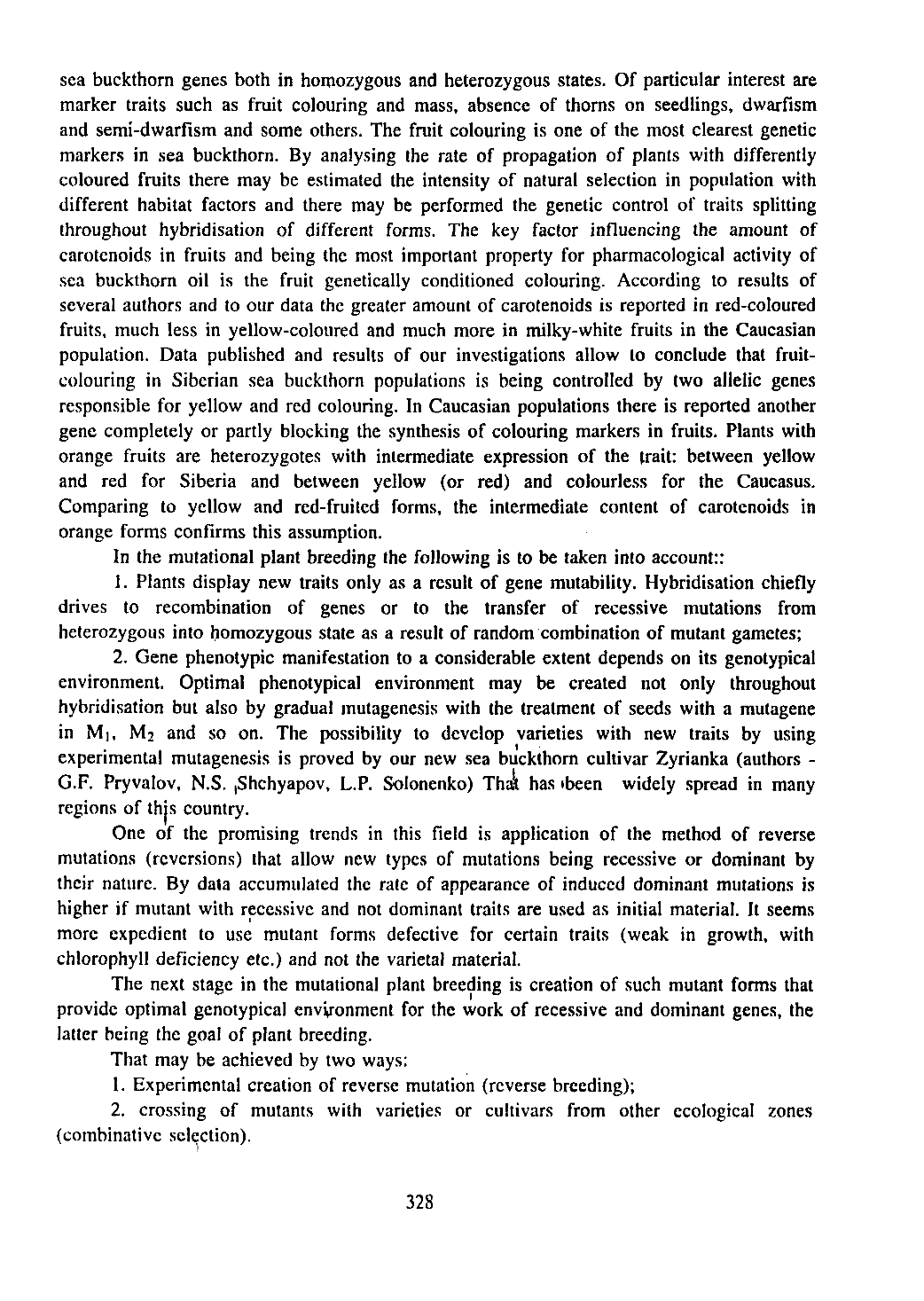

sea buckthorn genes both in homozygous and heterozygous states. O f particular interest are
marker traits such as fruit colouring and mass, absence of thorns on seedlings, dwarfism
and semi-dwarfism and some others. The fruit colouring is one of the most clearest genetic
markers in sea buckthorn. By analysing the rate of propagation of plants with differently
coloured fruits there may be estimated the intensity of natural selection in population with
different habitat factors and there may be performed the genetic control of traits splitting
throughout hybridisation of different forms. The key factor influencing the amount of
carotenoids in fruits and being the most important property for pharmacological activity of
sea buckthorn oil is the fruit genetically conditioned colouring. According to results of
several authors and to our data the greater amount of carotenoids is reported in red-coloured
fruits, much less in yellow-coloured and much more in milky-white fruits in the Caucasian
population. Data published and results of our investigations allow to conclude that fruit-
colouring in Siberian sea buckthorn populations is being controlled by two allelic genes
responsible for yellow and red colouring. In Caucasian populations there is reported another
gene completely or partly blocking the synthesis of colouring markers in fruits. Plants with
orange fruits are heterozygotes with intermediate expression of the trait: between yellow
and red for Siberia and between yellow (or red) and colourless for the Caucasus.
Comparing to yellow and red-fruited forms, the intermediate content of carotenoids in
orange forms confirms this assumption.
In the mutational plant breeding the following is to be taken into account::
1. Plants display new traits only as a result of gene mutability. Hybridisation chiefly
drives to recombination of genes or to the transfer of recessive mutations from
heterozygous into homozygous state as a result of random combination of mutant gametes;
2. Gene phenotypic manifestation to a considerable extent depends on its genotypical
environment. Optimal phenotypical environment may be created not only throughout
hybridisation but also by gradual mutagenesis with the treatment of seeds with a mutagene
in Mi, М
2
and so on. The possibility to develop varieties with new traits by using
experimental mutagenesis is proved by our new sea buckthorn cultivar Zyrianka (authors -
G.F. Pryvalov, N.S. ,Shchyapov, L.P. Solonenko) Thdt has ibeen widely spread in many
regions of thjs country.
One of the promising trends in this field is application of the method of reverse
mutations (reversions) that allow new types of mutations being recessive or dominant by
their nature. By data accumulated the rate of appearance of induced dominant mutations is
higher if mutant with recessive and not dominant traits are used as initial material. It seems
more expedient to use mutant forms defective for certain traits (weak in growth, with
chlorophyll deficiency etc.) and not the varietal material.
The next stage in the mutational plant breeding is creation of such mutant forms that
provide optimal genotypical environment for the work of recessive and dominant genes, the
latter being the goal of plant breeding.
That may be achieved by two ways:
1. Experimental creation of reverse mutation (reverse breeding);
2. crossing of mutants with varieties or cultivars from other ecological zones
(combinative selection).
328
Научная электронная библиотека ЦНСХБ









